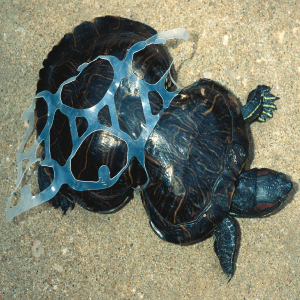What do you think of when you think of the ocean? You probably picture your family on the beach during a warm summer vacation or a scene of dolphins jumping through the water over a sunset. Many of us pay no attention to what happens in the ocean because we believe since it is out of sight, it is out of mind. The ocean is not all pretty blue waves like we think. There are many pollutants in the ocean that cause harm to all of the creatures living there. People pollute the ocean in so many ways that we do not realize. There are many types of ocean pollution caused by humans, and one of the biggest ones is plastic debris. Plastic debris is any kind of plastic that people use in their daily lives that eventually end up getting washed into the ocean. Common plastic items in the ocean are soda can holders, water bottles, and grocery bags.
 |
|
Figure 1 from N. Quiroga's article "Swims with Seals"
shows a victim of ocean pollution
|
Plastic holders from soda cans end up getting into waterways and then eventually they float along in the ocean. Sea turtles will get caught in the plastic rings and they have no way of getting them off. Shown to the left is an unfortunate victim of ocean pollution. Peanut the sea turtle got caught in a soda can ring when she was younger and she never got it off so her body grew around the plastic. Luckily, Peanut is fortunate enough to be healthy and alive today. Unlike Peanut, many sea turtles do not live, especially if they eat the plastic. Sounds weird right? Well, sea turtles mistake plastic, especially plastic trash bags, for their favorite food; jellyfish.
Among plastic debris, many unprofessional fishermen throw their fishing nets into the ocean when they are done with them. Sea lions love to try and play with the fishing nets or swim through them, and they end up getting tangled up, like the one shown below. When they cannot get themselves out of the nets, they ultimately die because they are not able swim fast enough to get away from prey or swim after their food.
 |
| Figure 2 from the Leeson Science Photo Library, is a sea lion trapped in a fisherman's net |
References
I would suggest making the first paragraph pop more by adding color to the words like warm summer, sunset and pollution to give the kids a sense of feeling. For example warm summer could be in yellow and pollution could be in dark brown. Also I would suggest adding ways for people and children to help prevent or clean up ocean pollution.
ReplyDeleteLooks great. Good use of color and formatted well four young kids. citations look good as well.
ReplyDelete